Often while reading WordPress tutorials, you may be asked to add custom code snippets in your theme’s functions.php file or in a site-specific plugin.
The problem is that even the slightest mistake can break your website.
In this article, we will show you an easy way to add custom code in WordPress without breaking your site.
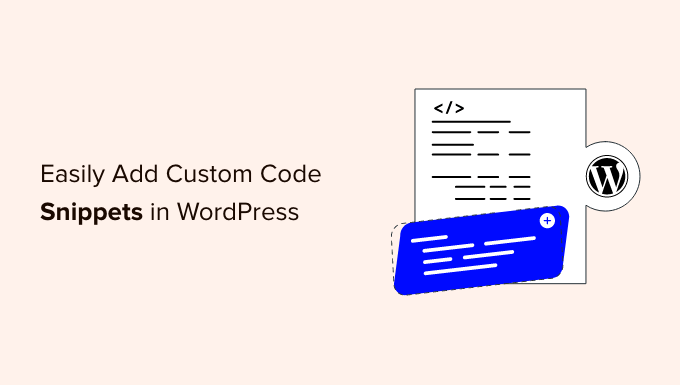
The Problem with Custom Code Snippets (And How to Fix It)
Often you’ll find code snippets in WordPress tutorials with instructions to add them into your theme’s functions.php file or a site-specific plugin.
The biggest problem is that even a tiny mistake in the custom code snippet can break your WordPress site and make it inaccessible.
Not to mention, if you update or change your WordPress theme, then all your customizations get removed.
The other problem is that if you add multiple code snippets in a site-specific plugin, it can become hard to manage the file.
Luckily, there is an easier way for users to add and manage custom code snippets in WordPress.
WPCode is the most popular code snippets plugin used by over 2 million WordPress websites. It makes it easy to add code snippets in WordPress without having to edit your theme’s functions.php file.

WPCode also makes it simple to add tracking codes for Google Analytics, Facebook Pixel, Google AdSense, and more to your site’s header and footer areas.
You’ll never have to worry about breaking your site because the smart code snippet validation helps you prevent common code errors.
In addition, WPCode comes with a built-in snippets library where you can find all of the most popular WordPress code snippets like disable REST API, disable comments, disable Gutenberg, allow SVG file uploads, and much more. This eliminates the need to install separate plugins for each feature request.
The best part is that you can manage all your code snippets from one central screen and add tags to organize them.
There’s also a free version of WPCode that has all of the basic features you need to add custom code in WordPress, including support for 6 code types, smart conditional logic, and more.
With that said, let’s take a look at how to easily add custom code snippets in WordPress with WPCode.
Video Tutorial
If you’d prefer written instructions, just keep reading.
Adding Custom Code Snippets in WordPress
The first thing you need to do is install and activate the free WPCode plugin on your website. For more details, see our step by step guide on how to install a WordPress plugin.
Note: The free WPCode plugin has everything you need to add custom code in WordPress. If you want advanced features like scheduled snippets, code revisions, eCommerce conversion tracking, and more, you can upgrade to WPCode Pro.
Upon activation, the plugin will add a new menu item labeled ‘Code Snippets’ to your WordPress admin bar. Clicking on it will show you a list of all the custom code snippets you have saved on your site.
Since you just installed the plugin, your list will be empty.
Go ahead and click on the ‘Add New’ button to add your first custom code snippet in WordPress.
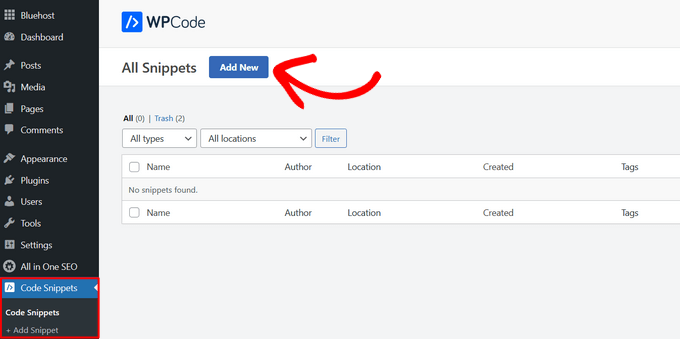
This will bring you to the ‘Add Snippet’ page. Here you can choose a code snippet from the pre-made library or add your custom code.
To add custom code, click on the ‘Use snippet’ button underneath the ‘Add Your Custom Code (New Snippet)’ option.
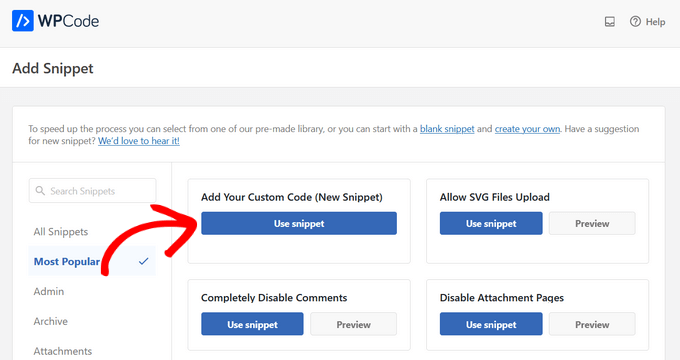
You need to start by entering a title for your custom code snippet. This could be anything that helps you identify the code.
After that, you can copy and paste your code snippet into the Code Preview box. Be sure to also select the correct code type from the drop-down menu on the right.
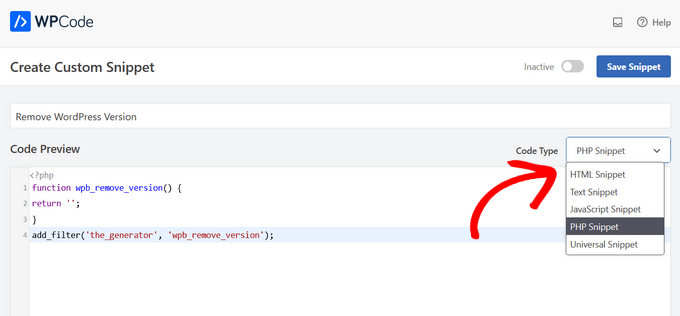
In the screenshot above, we have added a custom code snippet to remove the WordPress version number from our test site.
function wpb_remove_version() {
return '';
}
add_filter('the_generator', 'wpb_remove_version');
Below the code box, you will see insertion options. There are two main insertion options: Auto Insert and Shortcode.
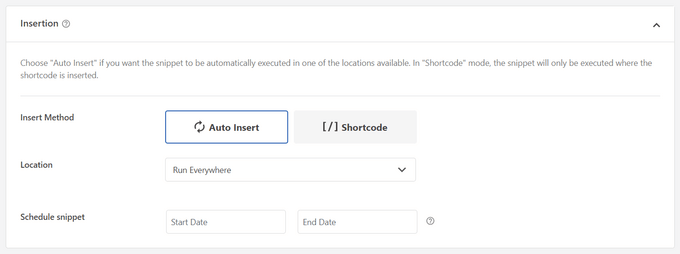
If you chose the ‘Auto Insert’ method, the snippet will be automatically inserted and executed on your site.
You can automatically run the snippet only in the WordPress admin area, on the front-end of your site, or everywhere. You can even choose to insert your snippet in page-specific locations like before or after posts or within post content.
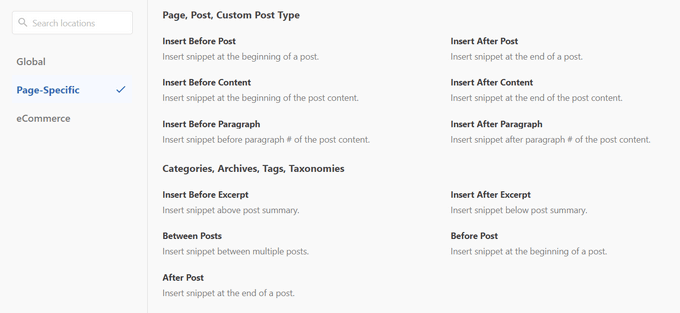
If you are unsure, then select the default ‘Run snippet everywhere’ option.
With the ‘Shortcode’ method, the snippet is not automatically inserted. Once you save the snippet, you’ll get a shortcode specific to the snippet that you can use anywhere on your site.
When you scroll further down, you can limit where you want the snippet to be loaded by device type. By default, snippets are loaded on all device types, but you can also set them to load on desktop only or mobile only.
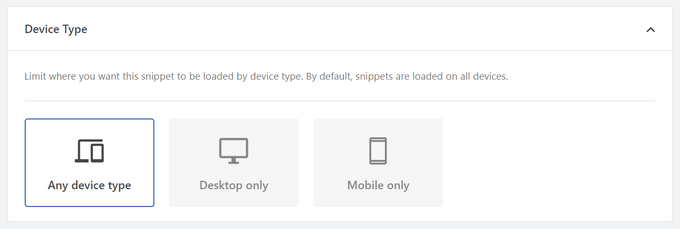
Next, you can use the powerful ‘Smart Conditional Logic’ section to either show or hide auto-inserted snippets based on a set of rules.
For example, you can show code snippets to logged-in users only, load code snippets only on specific page URLs, and more.

Lastly, you will see a ‘Basic info’ area. You can add anything here that helps you understand what this code does, where you found it, and why you are adding it to your website.
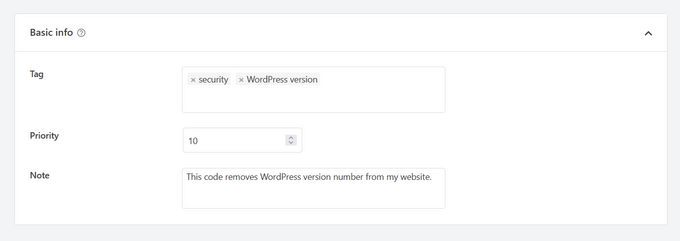
You can also assign tags to your code snippet. This will help you sort your code snippets by topic and functionality.
The priority field allows you to control the order in which the snippets are executed when you want to display multiple snippets in the same location. By default, all snippets get a priority of 10. If you want a snippet to display earlier than others, simply set the snippet priority to a lower number, like 5.
When you’re finished choosing options, toggle the switch from ‘Inactive’ to ‘Active’ in the top right corner and then click the ‘Save Snippet’ button.
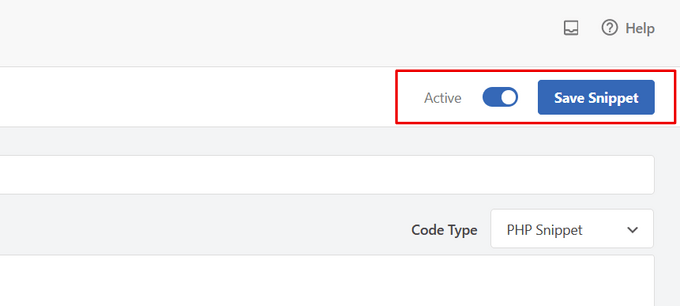
If you want to save the code snippet and not activate it, then simply click on the ‘Save Snippet’ button.
Once you have saved and activated the code snippet, it will be added to your site automatically, if that’s the insertion method you chose, or displayed as a shortcode.
Handling Errors in Custom Code
Often, if you make a mistake in adding the custom code in your site-specific plugin or theme file, then it would immediately make your site inaccessible.
You would start seeing a syntax error or a 500 internal server error on your site. To fix this, you’ll need to manually undo your code using an FTP client.
The neat part about the WPCode plugin is that it will automatically detect a syntax error in the code and immediately deactivate it.
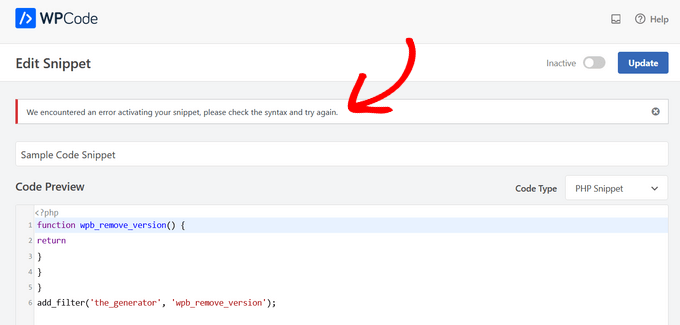
It will also show you a helpful error message, so you can debug the error.
WPCode’s smart code snippet validation will also detect any errors as you’re adding your custom code.
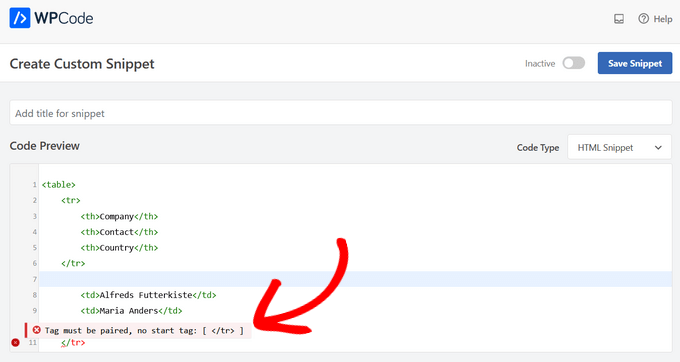
Hovering over the error will bring up instructions to help you fix it.
Managing Your Custom Code Snippets
WPCode plugin provides an easy user interface to manage your custom code snippets in WordPress.
You can save code snippets without activating them on your site, and then activate or deactivate the snippet at any time you want. It’s also possible to filter code snippets by type and location, and use tags to organize your code snippets easily.
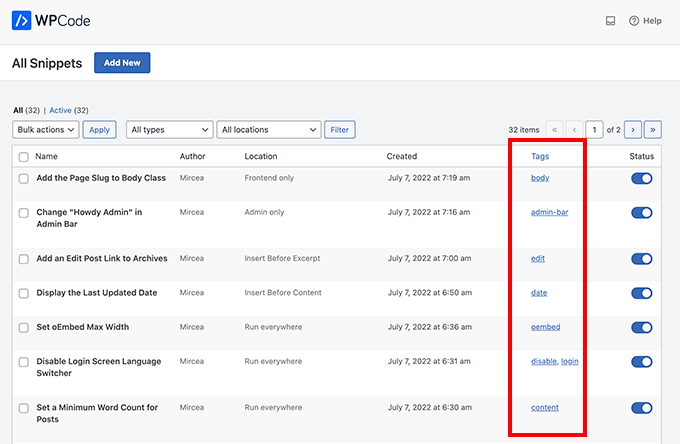
You can also export specific code snippets or bulk export all of them.
Simply go to Code Snippets » Tools and click on the ‘Export’ tab.
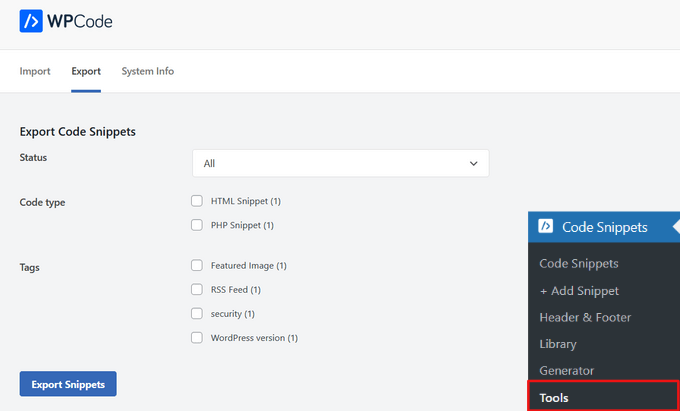
If you’re moving websites to a different server, you can easily import your code snippets to the new site.
Just visit the Code Snippets » Tools » Import page and upload the export file.
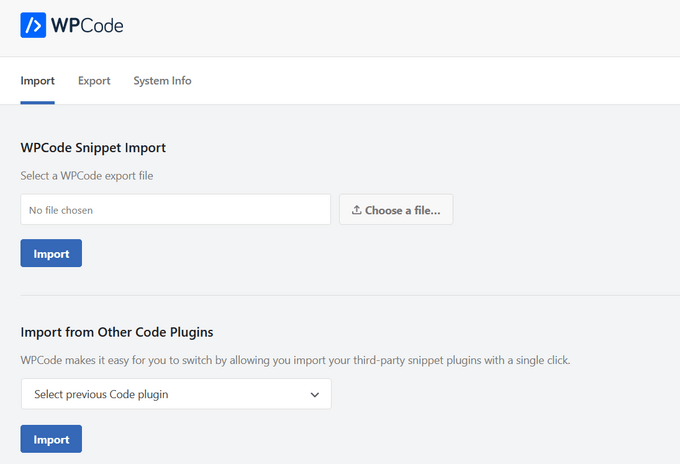
Bonus: Generate Custom Code Snippets with AI
Even if you don’t know how to code, you can easily create custom snippets for your WordPress website using WPCode’s AI Snippet Generator. So, instead of struggling with PHP, HTML, or CSS, you can describe what you want for your website in plain English.
From the ‘Add Snippet’ page, hover over the ‘Generate snippet using AI’ option. Then, click on the ‘+ Generate Snippet’ button.
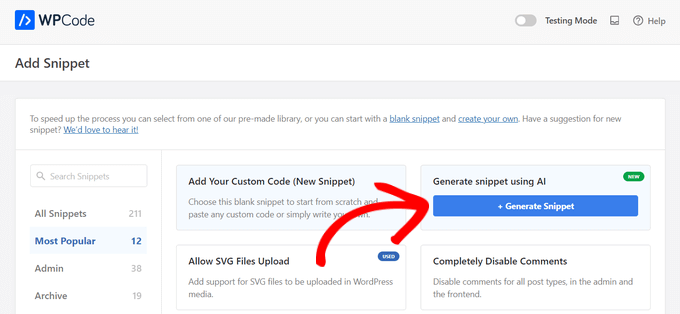
Next, a text box will pop up where you can describe what you want your snippet to do. Try to be specific about what you want, but don’t make it too long, you can always use the AI Improve feature to make additional changes later.
After typing your request, click on the ‘Generate’ button.

The AI will now write your new code snippet, as well as select the auto-insert location and set conditional logic, if needed.
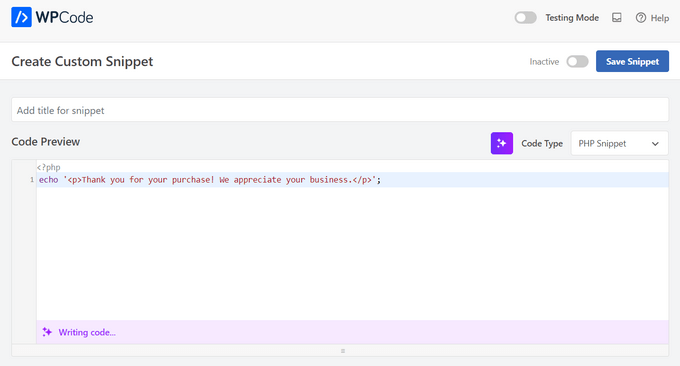
If you want to adjust your new snippet, you can click on the ‘AI Improve’ button, which will allow you to describe the changes you want to make.
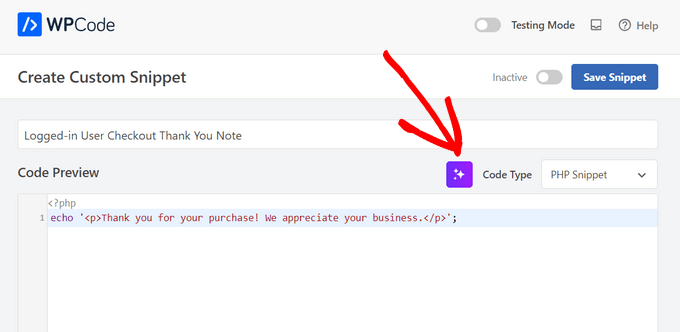
You can also use the AI Improve feature to enhance any of your existing code snippets.
We hope this article helped you learn how to easily add custom code in WordPress. Want to experiment with some code snippets on your website? Check out our list of extremely useful tricks for the WordPress functions file, and don’t forget to see our ultimate guide to speeding up your WordPress site.
If you liked this article, then please subscribe to our YouTube Channel for WordPress video tutorials. You can also find us on Twitter and Facebook.





Syed Balkhi says
Hey WPBeginner readers,
Did you know you can win exciting prizes by commenting on WPBeginner?
Every month, our top blog commenters will win HUGE rewards, including premium WordPress plugin licenses and cash prizes.
You can get more details about the contest from here.
Start sharing your thoughts below to stand a chance to win!
Moinuddin Waheed says
I have always had reservation for installing plugins for every functionality even very small functionality.
inserting code snippets through wpcode has revolunized it as we don’t need to have separate plugins for every small functionality that we need to have.
The better part is that wpcode comes with most used general code snippets which we have to just use and activate.
Jiří Vaněk says
I also use WP code for inserting snippets on the website, and I agree that it’s one of the indispensable tools in website creation if someone wants to save on installing numerous plugins, tasks that snippets can often handle well. What’s also good is that artificial intelligence can now suggest tailored snippets for many purposes.
WPBeginner Support says
Glad to hear you found the plugin helpful
Admin
C says
Great tutorial. How do you assign classes to WordPress elements.
Thanks.
WPBeginner Support says
We would recommend taking a look at our guide below for how to add your own classes to your site’s conent:
https://www.wpbeginner.com/wp-themes/wordpress-body-class-101-tips-and-tricks-for-theme-designers/
Admin
DAMIEN GALVEZ says
Thanks !! It was very helpful !!
WPBeginner Support says
Glad it was helpful!
Admin
ebere akadonye says
I have tried using the plugin, but whenever I am trying to activate my code, it returns an error in Line 0, I don’t know what to do next, because I can’t find any line 0. except it is the line with the <?php
Elena Ocone says
Hi and thank you so much for all your work and support to the WordPress community.
I used Code Snippets plugin and it was just perfect until after last update, when all code disappeared, and it became impossible to save any change: the result is a 404 error page.
WPBeginner Support says
You could try the troubleshooting steps in our article here: https://www.wpbeginner.com/beginners-guide/beginners-guide-to-troubleshooting-wordpress-errors-step-by-step/
to see if it could be a conflict with another plugin or theme
Admin
Romadhon Hapsa says
Thankyou for posting this. It works
WPBeginner Support says
Glad our article could help
Admin
Carol says
I have a long Authors page with affiliate links and want to have users be able to pull up those books for certain topics.
For instance, say that they are books covering Gardening, Cooking, and Sewing. I want the user to be able to pull up all the books on Sewing without having to see all the other titles. Plus some titles do not tell you immediately the subjects so browsing the entire list might not catch them all.
I want to be able to code the individual titles so they would appear on one or more of the predetermined subject lists and then provide a link to the user to click to get a dynamic list of just the titles on. that particular subject Dynamic such that any new titles I add and code will show up for them.
I am NOT a programmer, don’t want to be, I need a plugin that will do that. Seems that I am probably not the first person wanting to do this. Is there a plugin that will do this?
ton says
Hi
i am trying to have a function code added to the checkout page only , so how do I use the snippet to do so?
Lauren says
Can I apply code snippets to all pages EXCEPT my homepage?
THadryan says
I tried using this plug in because everyone seems to love it, but it crashed my whole site before I could even do anything with it.
This article convinced me to try it again, because everyone seems to like it, but EVEN JUST ACTIVATING it wrecks my whole site and I get the 500 error you refer to.
Do you have any idea what might be going on?
I would assume it’s my error but all I am doing is installing it and activating it.
WPBeginner Support says
Hi,
This could be due to a conflict with another plugin, theme, or custom code on your website. Please see our guide on troubleshooting WordPress errors to figure out what’s causing this issue.
Admin
PseudoGeek says
Would the code entered into this plugin persist through theme updates? Here’s what I’d like this plugin to do: In order to have the year update automatically in the copyright, many developers place a snippet of php code into a child theme to accomplish this. I really don’t want to make a child theme for every website just for that tiny change, but the alternative is to have my changes disappear with each theme update. But adding a child theme for something so minor seems like building a whole new fence when all you want to do is change the color of the latch on the gate. Maybe this plugin is the easy way to do this?
WPBeginner Support says
Theme updates won’t affect your code.
Admin
Al Klein says
I’m an old PHP developer, but this makes managing snippets a lot easier. (And, since I’m human, I made an error in adding a snippet – and it was just deactivated, Doing it manually would have meant making sure that the editor was still open when I tried the site, so I could go back and try to find what would have been a 500 error.
Thank you for this post.
Victorvijay says
What is the scope of this snippet?
Can this snippet code override any main theme functions?
Amrita says
Thanks for sharing this.I am also afraid of adding custom code.But this looks easy.If I understood correctly if the code snippet has an error the plugin automatically decativates it .Right?
WPBeginner Support says
Hey Amrita,
It tries to and can catch most common syntax errors, but sometimes it may fail to check. It all depends on the code you are trying to add.
Admin
Abdal Muntaqeem says
Thanks for this great plugin. Now I can manage custom snippets more easily.